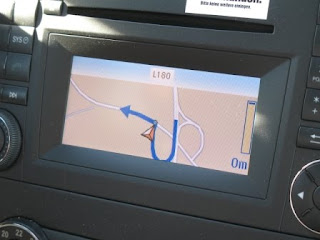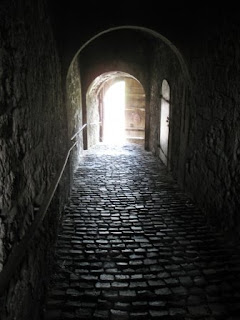 You know how it is: you spend your childhood in a town somewhere, you grow up and move away, and then when you come back to visit seventy years later, everything looks different. You wouldn't mind so much if someone had had the decency to ask or at least notify you before making the changes--before building the new roads and new houses, before replacing the obsolete train depot with a more modern one, before widening the quay and paving the dirt paths and opening the new eateries and expanding the schools and all that. If you're lucky, some of the old institutions are still around, like the Ox Restaurant where your dad used to hang out--but times have clearly changed, for now the kitchen closes for the afternoon and sorry, you'll have to go to the waterfront to find a bite to eat. Oh dear.
You know how it is: you spend your childhood in a town somewhere, you grow up and move away, and then when you come back to visit seventy years later, everything looks different. You wouldn't mind so much if someone had had the decency to ask or at least notify you before making the changes--before building the new roads and new houses, before replacing the obsolete train depot with a more modern one, before widening the quay and paving the dirt paths and opening the new eateries and expanding the schools and all that. If you're lucky, some of the old institutions are still around, like the Ox Restaurant where your dad used to hang out--but times have clearly changed, for now the kitchen closes for the afternoon and sorry, you'll have to go to the waterfront to find a bite to eat. Oh dear.I know how this is, and I've only been away from my home town for 23 years. Almost everything that has been done in Urbana, Illinois, since I left has been an improvement (the prairie grass trails through Meadowbrook Park, the statue gardens on and off campus, the state-of-the-art university buildings, the cleaned up Boneyard Creek), and many of my favorite old things remain (the classy tree-filled parks, the dust-covered plaster 3-D topology models in Altgeld Hall, the experimental cows with the windows in their stomachs). But every time I go back, something else has changed, some old restaurant has closed, some store has replaced another, and it's kind of weird and kind of disorienting.
We spent August 19, the second day of our reminiscence roadtrip, visiting several more places* where Helen had spent her youth, culminating in Ueberlingen.
With all the change Ueberlingen has seen since 1944, it is a wonder that we were able to find the Admiral's house. Helen directed us straight to it, past all the newer buildings she had never before set eyes on. "There should be some train tracks there...an alley here...some stone steps..."--and suddenly we were standing right in front of it. Admiral and Mutter Fischer had moved from the stately house next door to the small clapboard house after hard times forced them to downsize. Their son Peter was Helen's earliest childhood playmate--later her sweetheart, her fiance, her husband. It was in the small Fischer house that a young, widowed, and pregnant Helen lived with her in-laws after Peter's death during WWII.
We opened the gate into the wildflower-filled garden and knocked on the door. No answer. We called up to the open window. No answer. We poked around to the side of the house and knocked again. A woman opened the door and looked quizzically at us four strangers. After Stefan introduced Helen, the woman generously invited us in and gave us a tour.
"You'll see we've changed a few things," she said. "Look, here's where we moved the kitchen."
--"It used to be in the basement," said Helen.
We went upstairs.
"This is my room," the owner said.
--"Mutter Fischer's room," said Helen.
"And here's where my daughter sleeps," the owner said.
--"Lilo's room; she's 97 now and lives in Hamburg," said Helen.
"There was a son too, wasn't there? A soldier in North Africa and Italy," the owner said.
--"My husband," said Helen.
 After visiting the Fischer house, we set off to find the house Helen's father had built when they lived in Ueberlingen. "Most of these are new," Helen said of the buildings en route; "maybe the house isn't there anymore." But it was, and it looked quite grand: a massive American foursquare for the American Stoll. No one answered our knocks. We took a photo of Helen standing by the front door more than seven decades after her family had moved east to Bavaria.
After visiting the Fischer house, we set off to find the house Helen's father had built when they lived in Ueberlingen. "Most of these are new," Helen said of the buildings en route; "maybe the house isn't there anymore." But it was, and it looked quite grand: a massive American foursquare for the American Stoll. No one answered our knocks. We took a photo of Helen standing by the front door more than seven decades after her family had moved east to Bavaria.Walking back down the hill on the stone steps behind the Fischer house, Stefan received some sad news on his cell phone: 97-year-old Lilo had passed away in her sleep the night before. "We were meant to come here," Helen said; "this was a gift from Lilo."
*First stop: Meersburg, a beautiful historic town on the Bodensee (Lake Konstanz), densely packed with scenic views--old old castles and old new castles, wattle-and-daub houses, medieval walls, creaky water mills, turrets and towers--all piled one atop the other. Despite all the buildings that have stood there for centuries, change nonetheless comes to towns that build their economies around well-preserved Altstaedte. Second stop: the baroque church in Birnau, in front of which Helen spent many an hour flirting with Peter.
















































